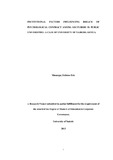| dc.description.abstract | The purpose of this study was to investigate the institutional factors that influence breach of psychological contract among lecturers in public universities: A case of University of Nairobi. The target population was the 1403 lecturers at the University of Nairobi out of which 210 were sampled. Using case study research design, the study found out that despite lecturers having fulfilled their commitments to the university, the university had not fulfilled its side of the psychological contract. Only 30 percent of lecturers had a positive psychological contract. The study revealed that the areas where psychological contract breaches were perceived included teaching load, inadequate teaching and research resources and facilities and inadequate fringe benefits. Others included managements’ inability to explain to lecturers decisions made, lack of acknowledgement of the long hours lecturers devoted to work, lack of enough focus on students’ success and inadequate support for professional development. This led to lecturers’ demotivation, dissatisfaction and reduced commitment that made some engage in moonlighting as others did nothing while others continued working hard waiting for greener pastures. The study also found out that 52.2 percent of female as compared to only 21.2 percent of male lecturers had a positive psychological contract. Similarly, only one (1) part time lecturer had a positive psychological contract while 84.2 percent of lecturers with low psychological contract were at the level of senior lecturer and lecturer and that, 79.4 percent of lecturers with a low psychological contract had worked at the University for Six years and more. | |

